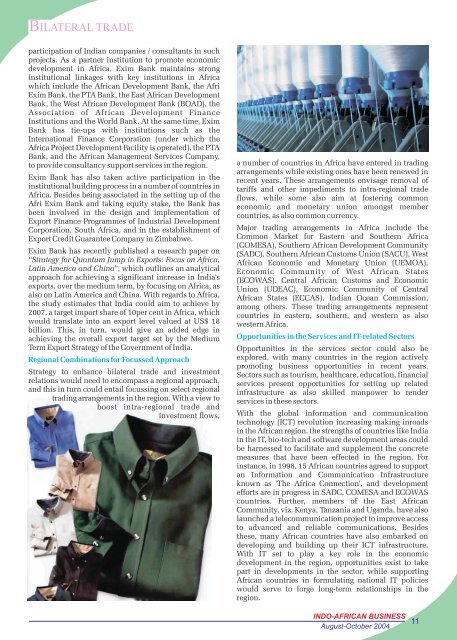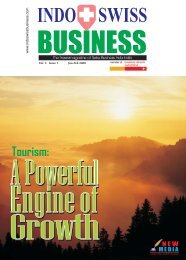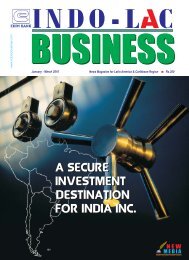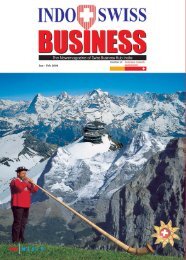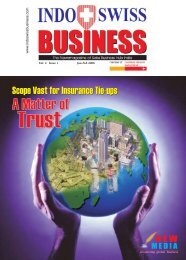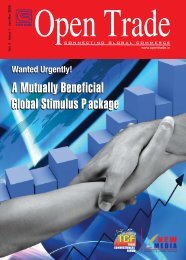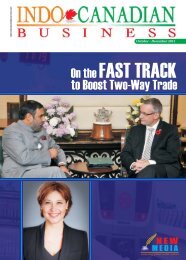Linking Africa and India - new media
Linking Africa and India - new media
Linking Africa and India - new media
You also want an ePaper? Increase the reach of your titles
YUMPU automatically turns print PDFs into web optimized ePapers that Google loves.
BILATERAL TRADEparticipation of <strong>India</strong>n companies / consultants in suchprojects. As a partner institution to promote economicdevelopment in <strong>Africa</strong>, Exim Bank maintains stronginstitutional linkages with key institutions in <strong>Africa</strong>which include the <strong>Africa</strong>n Development Bank, the AfriExim Bank, the PTA Bank, the East <strong>Africa</strong>n DevelopmentBank, the West <strong>Africa</strong>n Development Bank (BOAD), theAssociation of <strong>Africa</strong>n Development FinanceInstitutions <strong>and</strong> the World Bank. At the same time, EximBank has tie-ups with institutions such as theInternational Finance Corporation (under which the<strong>Africa</strong> Project Development Facility is operated), the PTABank, <strong>and</strong> the <strong>Africa</strong>n Management Services Company,to provide consultancy support services in the region.Exim Bank has also taken active participation in theinstitutional building process in a number of countries in<strong>Africa</strong>. Besides being associated in the setting up of theAfri Exim Bank <strong>and</strong> taking equity stake, the Bank hasbeen involved in the design <strong>and</strong> implementation ofExport Finance Programmes of Industrial DevelopmentCorporation, South <strong>Africa</strong>, <strong>and</strong> in the establishment ofExport Credit Guarantee Company in Zimbabwe.Exim Bank has recently published a research paper on“Strategy for Quantum Jump in Exports: Focus on <strong>Africa</strong>,Latin America <strong>and</strong> China”, which outlines an analyticalapproach for achieving a significant increase in <strong>India</strong>'sexports, over the medium term, by focusing on <strong>Africa</strong>, asalso on Latin America <strong>and</strong> China. With regards to <strong>Africa</strong>,the study estimates that <strong>India</strong> could aim to achieve by2007, a target import share of 10per cent in <strong>Africa</strong>, whichwould translate into an export level valued at US$ 18billion. This, in turn, would give an added edge inachieving the overall export target set by the MediumTerm Export Strategy of the Government of <strong>India</strong>.Regional Combinations for Focussed ApproachStrategy to enhance bilateral trade <strong>and</strong> investmentrelations would need to encompass a regional approach,<strong>and</strong> this in turn could entail focussing on select regionaltrading arrangements in the region. With a view toboost intra-regional trade <strong>and</strong>investment flows,a number of countries in <strong>Africa</strong> have entered in tradingarrangements while existing ones have been re<strong>new</strong>ed inrecent years. These arrangements envisage removal oftariffs <strong>and</strong> other impediments to intra-regional tradeflows, while some also aim at fostering commoneconomic <strong>and</strong> monetary union amongst membercountries, as also common currency.Major trading arrangements in <strong>Africa</strong> include theCommon Market for Eastern <strong>and</strong> Southern <strong>Africa</strong>(COMESA), Southern <strong>Africa</strong>n Development Community(SADC), Southern <strong>Africa</strong>n Customs Union (SACU), West<strong>Africa</strong>n Economic <strong>and</strong> Monetary Union (UEMOA),Economic Community of West <strong>Africa</strong>n States(ECOWAS), Central <strong>Africa</strong>n Customs <strong>and</strong> EconomicUnion (UDEAC), Economic Community of Central<strong>Africa</strong>n States (ECCAS), <strong>India</strong>n Ocean Commission,among others. These trading arrangements representcountries in eastern, southern, <strong>and</strong> western as alsowestern <strong>Africa</strong>.Opportunities in the Services <strong>and</strong> IT-related SectorsOpportunities in the services sector could also beexplored, with many countries in the region activelypromoting business opportunities in recent years.Sectors such as tourism, healthcare, education, financialservices present opportunities for setting up relatedinfrastructure as also skilled manpower to renderservices in these sectors.With the global information <strong>and</strong> communicationtechnology (ICT) revolution increasing making inroadsin the <strong>Africa</strong>n region, the strengths of countries like <strong>India</strong>in the IT, bio-tech <strong>and</strong> software development areas couldbe harnessed to facilitate <strong>and</strong> supplement the concretemeasures that have been effected in the region. Forinstance, in 1998, 15 <strong>Africa</strong>n countries agreed to supportan Information <strong>and</strong> Communication Infrastructureknown as 'The <strong>Africa</strong> Connection', <strong>and</strong> developmentefforts are in progress in SADC, COMESA <strong>and</strong> ECOWAScountries. Further, members of the East <strong>Africa</strong>nCommunity, viz. Kenya, Tanzania <strong>and</strong> Ug<strong>and</strong>a, have alsolaunched a telecommunication project to improve accessto advanced <strong>and</strong> reliable communications. Besidesthese, many <strong>Africa</strong>n countries have also embarked ondeveloping <strong>and</strong> building up their ICT infrastructure.With IT set to play a key role in the economicdevelopment in the region, opportunities exist to takepart in developments in the sector, while supporting<strong>Africa</strong>n countries in formulating national IT policieswould serve to forge long-term relationships in theregion.INDO-AFRICAN BUSINESS 11August-October 2004


